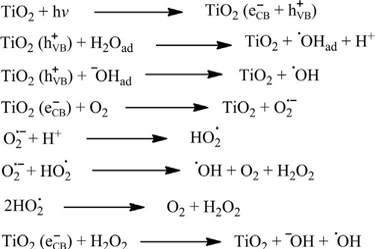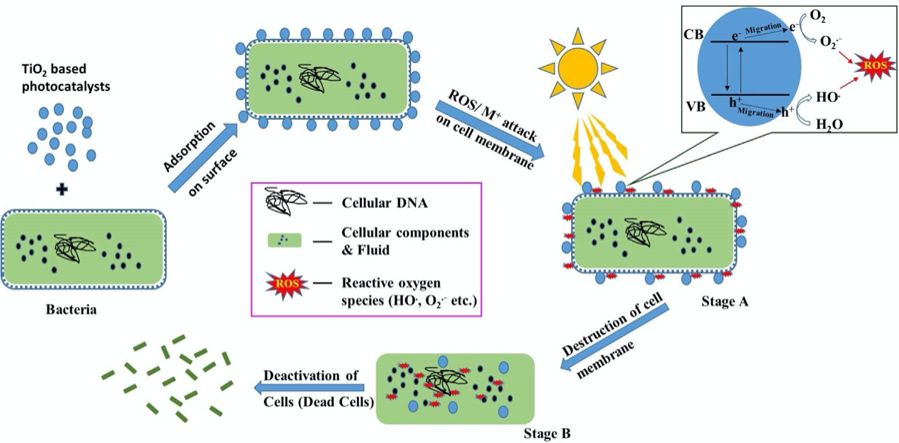TiO2-based photocatalytic disinfection of microbes
Published by George & Peter,
The TiO2 based photocatalyst has great potential for the disinfection/inactivation of harmful pathogens (such as E.coli in aqueous media) along with its well-known usefulness on various chemical pollutants. The disinfection property of TiO2 is primarily attributed to surface generation of reactive oxygen species (ROS) as well as free metal ions formation. Furthermore, its disinfection capacity and overall performance can be significantly improved through modifications of the TiO2 material. In this review, we provide a brief survey on the effect of various TiO2 materials in the disinfection of a wide range of environmentally harmful microbial pathogens (e.g., bacteria, fungi, algae, and viruses) in aqueous media. The influencing factors (such as reactor design, water chemistry, and TiO2 modifications) of such processes are discussed along with the mechanisms of such disinfection. It is believed that the combined application of disinfection and decontamination will greatly enhance the utilization of TiO2 photocatalyst as a potential alternative to conventional methods of water purification.


S NO | Type | Photocatalyst | Concentration | Duration | Efficiency | Reference |
A. Bacteria
1 | E. coli | Modified rutile TiO2 | 5 mg | 64% | Song et al. (2015) | |
2 | E. coli | Ag@TiO2 nanoparticles | 0.4 g/L | 100% | Sreeja and Shetty (2016) | |
3 | E. coli | TiO2− 2% GO nanocomposites
| 90 min | 100.00% | Wang et al. (2016) | |
4 | E. coli | 40% TiO2 -Bi2WO6 | 100 mg/mL | 4 h | Jia et al. (2016) | |
5 | E. coli | TiO2-Fe3O4 hollow spheres | 4 h | 100% | Ren et al. (2015) | |
6 | E. coli | TiO2–graphene–porphyrin nanocomposite | 440 min | 64% | Rahimi et al. (2015) | |
7 | E. coli | g-C3N4)/TiO2 | 180 min | 100% | G Li et al. (2015); Y Li et al. (2015) | |
8 | E. coli | Nano TiO2 | 1 g L−1 | 180 min | 100% | Massard et al. (2013) |
9 | E. coli | GO-TiO2-Ag | 120 min | 100% | Liu et al., 2013 | |
10 | E. coli | TiO2 nanotube | 2 g/L | 50 min | 95% | Ng et al. (2010) |
11 | E. coli | (Fe, N)-doped TiO2 | 8 h | 94.50% | He et al. (2009) | |
12 | S. Aureus | Silver-modified TiO2/ZnO plasmonic photocatalysts | 2 h | 99.90% | Tallosy et al. (2014) | |
13 | P. Aeuroginosa | Ag-doped TiO2 nanoparticles | Gupta et al. (2013) | |||
14 | L. monocytogens | Nano-TiO2 | 1.0 g/L | 180 mins | Long et al. (2014) | |
B. Fungi
15 | Candida albicans | TiO2 | 80% | Tatlidil et al. (2011) | ||
16 | Fusarium solani | TiO2 | 10–500 mg/L | Fernández-Ibáñez et al. (2009) | ||
C. Virus
17 | Bacteriophage MS2 | nAg/TiO2 | Liga et al. (2011) | |||
18 | phage MS2 | TiO2-FeSO4 | 99.9% | Jogren and Sierka (1994) | ||
D. Protozoa
19 | Cryptosporidium | TiO2 | 200 mg/L | 5 h | 82.10% | Abeledo-Lamiero et al. (2016) |
20 | Giardia lamblia | TiO2 | Navalon et al. (2009) | |||
E. Algae
21 | Anabaena flos-aquae
| TiO2 | Ochiai et al. (2010) | |||
22 | Chlorella | TiO2 NPs | 10 mg/L | Lin et al. (2014) |
